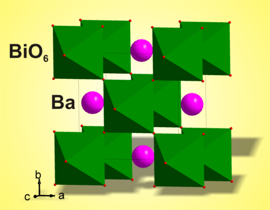
Diagram of the crystal structure of BaBiO3
Russian chemists, together with an Italian colleague, proposed a new method for producing barium bismuthate, a promising material for processing organic waste and producing hydrogen fuel from water. The new method helped increase the reactivity of the compound, making it more efficient at breaking down organic pollutants. The results of the study, supported by a grant from the Russian Science Foundation (RSF), are published in the journal Photochemical and Photobiological Sciences.
Waste disposal is one of the most pressing environmental problems faced by humanity. Organic waste such as discharges from chemical plants and pesticides pose a threat to ecosystems and human health, which is why scientists are looking for effective ways to convert them into safer compounds. Photocatalytic materials are promising, which, when exposed to sunlight, break down organic pollutants to simple molecules, such as carbon dioxide and water. Most often, inexpensive and stable titanium oxide is used in this role, but it is effective only when irradiated with ultraviolet light, which casts doubt on its industrial use, since special lamps cannot be dispensed with. Chemists have recently proposed new bismuth-based photocatalytic materials that are activated by sunlight.
Barium bismuthate (BaBiO3) effectively decomposes organic pollutants, splits water and carbon dioxide, so it can be used for waste disposal, reducing CO2 levels in the atmosphere, and even for making hydrogen fuel. But the generally accepted method for the synthesis of bismuthate from carbon-containing compounds does not allow obtaining a pure material – it always turns out to be contaminated with carbonate, which reduces the chemical activity of the photocatalyst and complicates the study of its structure and properties.
Scientific group from the Far Eastern Federal University (Vladivostok), St. Petersburg State University (St. Petersburg), Far Eastern State Transport University (Khabarovsk), L.V.Kirensky Institute of Physics (Krasnoyarsk), Siberian Federal University (Krasnoyarsk) with colleagues from the University of Pavia (Italy) synthesized barium bismuthate by a new method – from barium oxide and nitrate, which helped to avoid carbonate impurities in the material. For this, a mixture of barium oxide and nitrate was thoroughly ground and sintered at high temperatures. Then, thin films were formed from the resulting powder on a quartz substrate. After that, the researchers determined the chemical composition and band structure of the samples – the distribution of the electron energy bands over the allowed and forbidden levels. The band structure determines the photocatalytic properties of semiconductor materials, which include barium bismuthate, but this compound has not previously been unambiguously understood.
The results of the analysis showed that bismuth in the composition of the particles of the material is present in different oxidation states: there are ions Bi3 +, which have lost three electrons, and Bi5 +, which lack five electrons. The presence of two variants of bismuth and superoxide radicals in the material provided the photocatalytic properties of the samples.
To assess the photocatalytic activity of barium bismuthate, chemists added it to an aqueous solution of phenol and tracked how quickly the organic molecules decay. Phenol is widely used in the chemical industry, oil refining, medicine and even cosmetology, but it is quite toxic. It turned out that the reaction of its decomposition proceeded faster with barium bismuthate than in the presence of titanium oxide. To find out the mechanism of the process, scientists additionally introduced into the reaction various radical scavenger substances, which interacted either with electrons released from bismuthate in the light, or with positively charged holes from which they flew. In the course of experiments, it was possible to show that the photocatalytic activity of barium bismuthate is due to photoholes and superoxide radicals – active particles formed on the surface of a material from ordinary oxygen due to the attachment of electrons. It is they who attack phenol dissolved in water, destroying it.
“The results of our study will help to predict in which other reactions the photocatalytic activity of barium bismuthate may be manifested. This will make it possible to use it in several areas of an ecologically clean, so-called “green” economy, for example, for the purification of wastewater from organic pollutants, as well as for the photocatalytic production of hydrogen from water for the needs of hydrogen energy “, – sums up the project manager for the grant Russian Science Foundation Dmitry Shtarev, PhD in Physics and Mathematics, Leading Researcher, Laboratory of Film Technologies, Department of Physics of Low-Dimensional Structures, Institute of Science-Intensive Technologies and Advanced Materials, as well as Deputy Director of the Institute for Research, Far Eastern Federal University.
Read also:
Lectures by leading Russian scientists will be held at Moscow State University
Noise will help physicists “catch” elusive quantum states
Hot, mechanical, yours: the receptors that brought the Nobel Prize
“At the fundamental level, we see no limitations”: what the new sensor for MEG is capable of
Hello Mercury!

